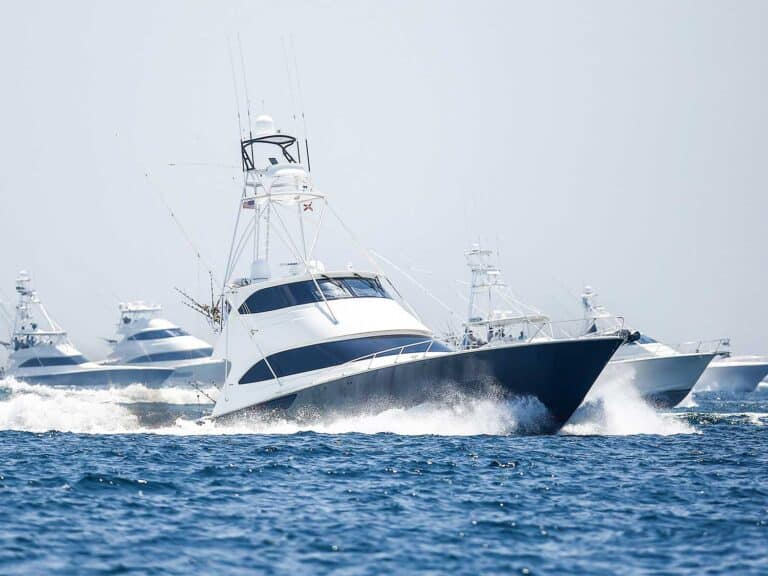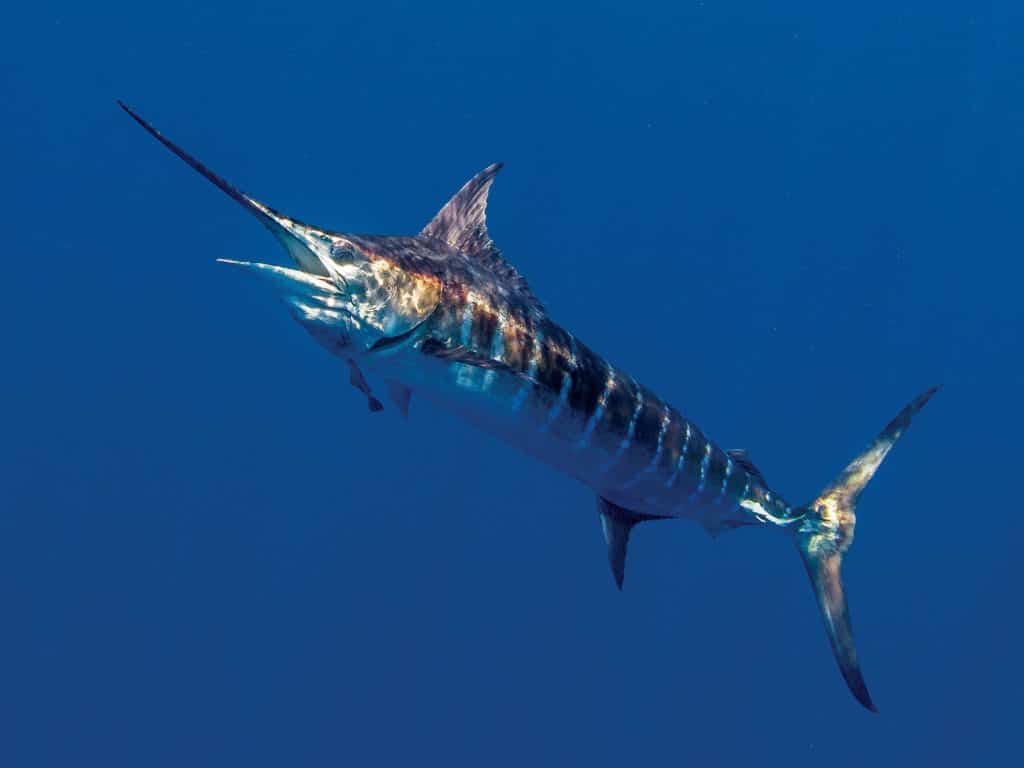
If you really want to catch your first blue marlin, the Dominican Republic is almost a sure bet during different times of the year. Blue marlin season runs from March through September, with white marlin also abundant especially in May and June. It’s an extremely interesting location, with dozens of the best-of-the-best sport-fishing boats spending months there every year. I was first there several years ago with Joan Vernon fishing aboard Tijereta with Capt. Bubba Carter. During that trip, we were based out of Cap Cana and caught several white marlin, but we weren’t able to connect with any blues.
Fortunately, I recently had a chance to visit the DR again when Rufus Wakeman invited me to join him and Scott Loper aboard the 48-foot G&S Chaser with Capt. Tim Richardson at Casa de Campo. Wakeman was on a quest to catch every species of billfish on a fly rod within one calendar year, and Atlantic blue marlin was on his list. He’d been to the DR the year before and caught a blue, but this time, he was hoping to catch another and maybe add a white to his collection.
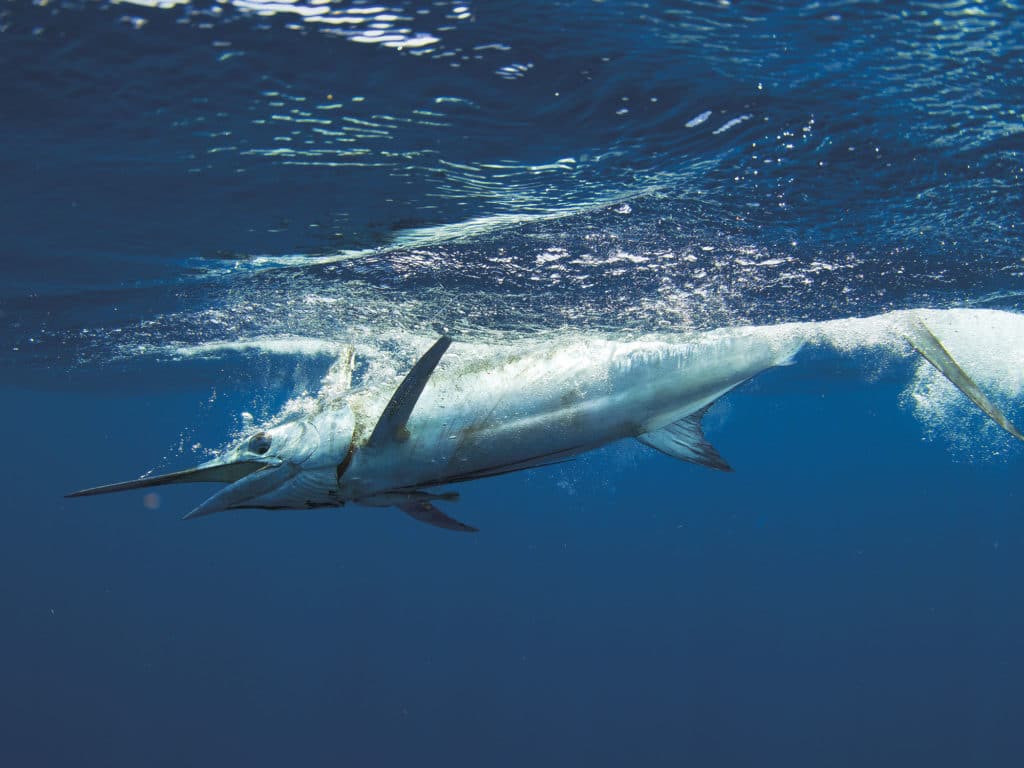
Light-Tackle Blues
Chaser was docked on the southeast coast at Casa de Campo, about an hour from the Punta Cana airport. The 400-berth marina is nestled in a 7,000-acre private community that is aptly described as exclusive. There are some 1,600 villa owners, and the houses and landscaping are impressively elegant, with convenient and reasonably priced restaurants nearby. Everything is simply first class. Richardson rented a condo for his charter clients, which allowed the boat to be docked at their back door, so logistics couldn’t have been better.
When we arrived at the condo, Richardson went over the daily plan with us. Chaser would leave the dock around 7 each morning and run to the fishing grounds about an hour away: a series of FADs located some 18 to 35 miles offshore. The day we arrived, Chaser caught two blues and a white, but it’s not unusual to release several blue marlin in a day when fishing in the DR. The blues range from 80 to 175 pounds, with a 300-pounder thrown into the mix on occasion. The small average size makes them perfect for light-tackle anglers, especially on fly — the reason for Wakeman’s trip.
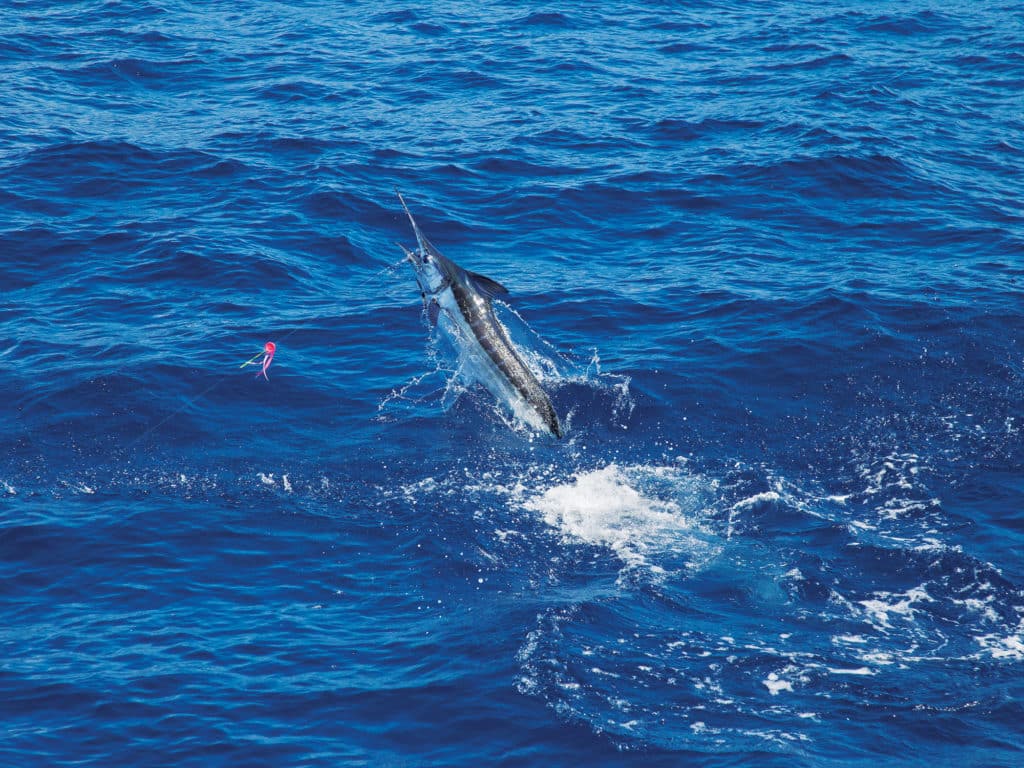
Local Ways
The waters along the southeast coast of the DR are unique. A quarter-mile from the marina, the depths quickly exceed 1,000 feet. Local commercial fishermen deploy FADs not only as a source of survival but as a way to provide for their families. Their catches are usually meat fish, but marlin are caught and brought to the market often. Deployed by groups of local fishermen, the FADs are constructed primitively, typically made from trash and palm fronds to create structure on the surface to attract baitfish. A derelict 100-pound propane tank or 50-gallon barrel filled with concrete and strung with PVC pipes or sticks allows it to grab hold of the seafloor, anchoring it to the bottom in depths often exceeding 4,000 feet. Try to imagine carting a 400-pound concrete ball with spikes sticking out of it along with a mile of rope 30 miles offshore in a panga with a 40 hp motor — a true feat to accomplish. Today, there are literally hundreds of FADs off the coast of the Dominican Republic. Individuals fish the FADs they deploy and, as expected, are a bit possessive of them and not fond of the American sport-fishing fleet.
We were always in sight of a FAD while fishing. We saw several local pangas each day, some friendly and some outright hostile. Chaser‘s mate, Garrett Penley, showed me an amazing GoPro video of a panga running down a blue marlin they had hooked, trying to grab the line and gaff the fish. Evidently, this was a fairly common incident in years past, and relations between the native commercial fishermen and the sport-fishing fleet became increasingly strained. The marina at Casa de Campo now adds an additional $500 to every boat’s docking fee to help the locals launch and maintain their FADs, which has helped calm relations a bit. This is an interesting and complex clash of customs. Very few anglers kill marlin anymore. Thirty years ago, we all thought the supply of billfish was unlimited. Now we know that’s not true, and if you keep killing marlin in a specific area, eventually they aren’t going to be there anymore. However, this long-term projection has little impact on a DR native who is desperately trying to feed his family. In the DR, a 150-pound marlin is a big payday for a local fisherman who uses a hand line because he can’t afford a rod and reel.
The Task at Hand
Wakeman was fly-fishing, so we trolled a series of hookless baits and teasers. While the DR is one of the primo spots in the world, marlin are still marlin. On a good day in the DR, you can raise a dozen blues; on a bad day, you can get skunked just like everywhere else. Add fly-fishing into the mix and you’ve just upped the degree of difficulty tenfold.
Wakeman cast the fly, and nothing happened. Then we heard Richardson yell from the bridge, “Here he comes!”
We raised only two fish on the first day, and neither teased into range of Wakeman’s fly. During the second day, the first fish we saw followed the teaser right up to the boat. This was only the second blue marlin I’ve seen teased into fly range, but it was not as aggressive as I expected. Penley lured the fish in, Richardson took the engines out of gear, Wakeman cast the fly, and nothing happened. It was probably only a few seconds, but it seemed like a long time as we made excuses: fish not excited enough, it never really got a taste of the bait, we shouldn’t have used a dredge, etc. All the while, the fly was floating behind the boat, with Wakeman giving it a little pop every so often. Then we heard Richardson yell from the bridge, “Here he comes!” and a 130-pound blue marlin calmly swam over and ate the fly, a textbook bite going away. Wakeman set the hook, and we were in business. I was impressed how well Wakeman’s 15-weight Tycoon rod and Nautilus Monster reel handled the marlin. The fight was smooth, with lots of jumps, and the fish never really sounded like blues tend to do. Its color was incredible, right up to when Penley grabbed its nose for a quick photo. There were no pangas in sight and no problems. Later that day, Loper released a nice blue on 30-pound conventional tackle.
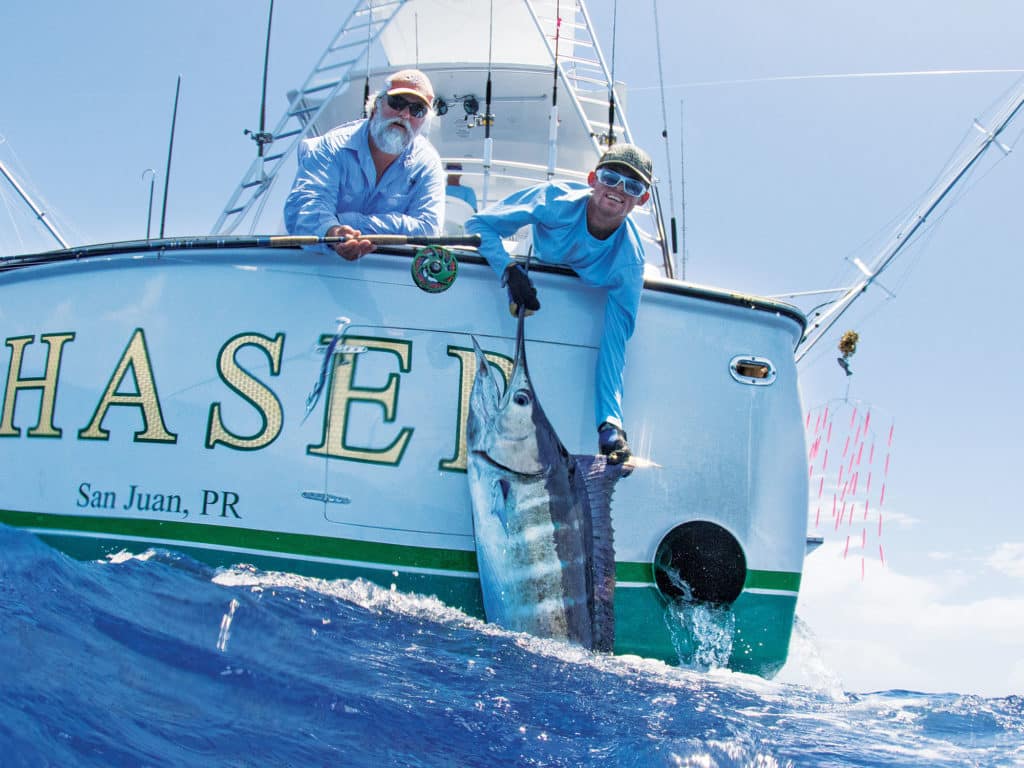
Interactions on the FADs
The next day, we had our first experience with a panga incident. When we arrived on the first FAD, a panga was fishing around it. Richardson kept his distance, but the locals fired up and began buzzing us, running right at our lines as if they were going to cut them. They then ran right up to us, shouting and making some rather unfriendly hand gestures that indicated they were less than pleased about our presence. They eventually got bored and went back to fishing, so we moved on. They must have put the whammy on us because we drew a blank that day.
Our last day of fishing started out quite well. When we pulled up to our first FAD, again, a panga was fishing on it. The guys recognized Chaser and were very friendly. They motored over, and we gave them some water and wished them well. They went back to fishing and promptly caught a marlin, then followed it up with several big dolphin. We finally hooked up, and Loper caught another blue on a lure that allowed me to get fairly close for some underwater photos. Hooked billfish are not fond of me or my underwater camera. They must see me as some form of mutant shark and stay as far away as possible, but the guys in the panga thought it was great to see a crazy gringo jump out of a big fancy boat and start chasing after a hooked marlin. When my swim was over, they called us over and asked if I wanted to swim with some dolphin that were hanging around their skiff, which I did. In addition, their FAD was interesting and held multiple species of fish, so I spent quite awhile checking it out.
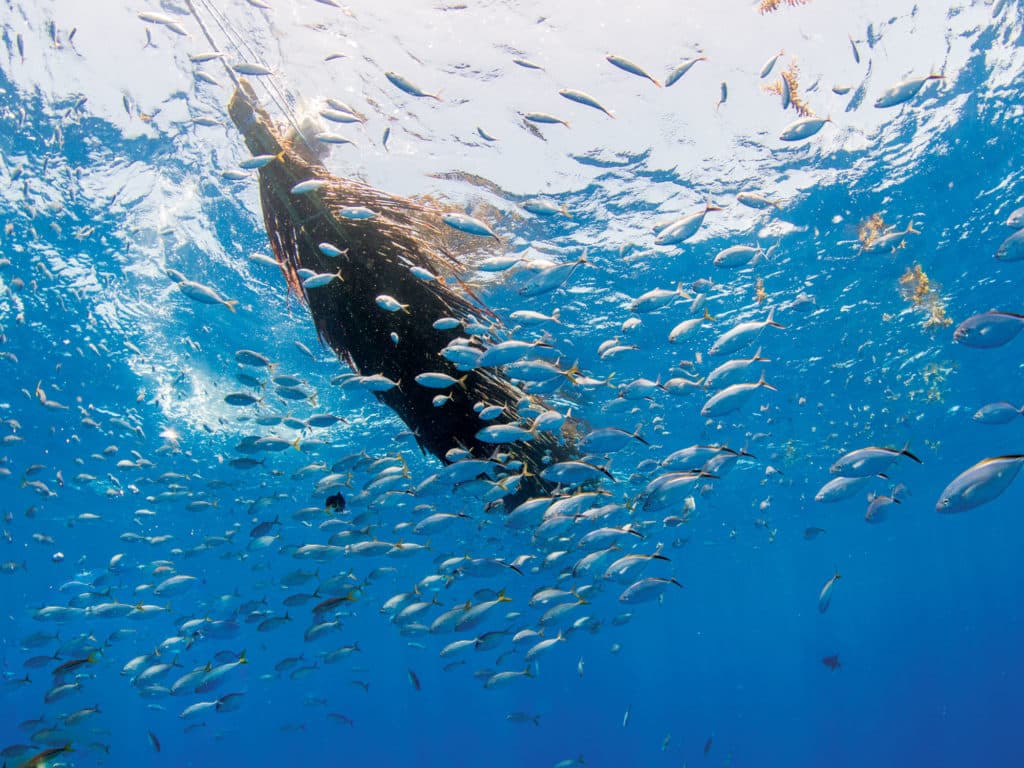
After I got out of the water and we went back to fishing, we watched as the panga landed a second marlin. It was interesting to see them fish the hand line, which appeared to be a 1- or 2-pound spool of 100-pound-test mono. One guy pulled on the fish while the other held and rewound the spool of line. I don’t know how they managed to hang on during the marlin’s first few runs, but they did.
As the day wore on, the panga stayed with us. Wakeman caught another blue on bait, and we had two more knockdowns that didn’t result in a hookup. Then around 4 p.m., the panga guys hooked another marlin and began waving us over. As it turned out, they were inviting Penley, who spoke Spanish, to come aboard and help them land the fish. We all thought their invitation was amusing, and we wanted to see how Penley performed with a hand line — he actually did pretty well. I jumped in the water to try to get a few photos of their fish until they politely asked me to get out because I was scaring it away from the boat. It was engrossing to watch Penley help them fight the fish and then work with them to boat it. It always stresses me out to see a billfish killed, but this was an interesting experience to witness and a reality these local fishermen face on a daily basis. As we motored home at day’s end, Richardson was the first to remind us that we were outfished by a panga — it helps to keep a good sense of humor.
A Good Bet
The day after we left, Richardson and Penley moved Chaser from Casa de Campo up the coast to Cap Cana where the white marlin run was just getting into high gear. The blue marlin were expected to taper off for a few months, then reappear in late summer. At Cap Cana, the white marlin bite is only 3 to 10 miles offshore and the American boats look for drop-offs and bottom patterns rather than FADs.
I have no idea why moving 50 miles up the coast would make such a difference in the placement and effectiveness of the FADs, but it obviously does. The marlin fishing in the DR has unlimited potential and might be as close to a sure thing as can be imagined. Catching a blue marlin, no matter what their size, is never an easy task, but the Dominican Republic is the place to go if you want to increase your odds of catching at least one.
Check out some great video action of offshore fishing in the Dominican Republic.





